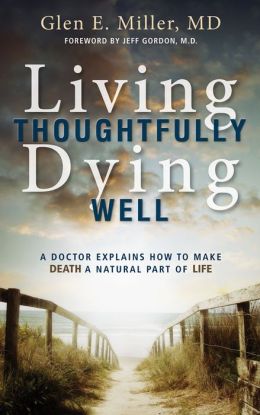Mennonite Health Journal
Articles on the intersection of faith and health
Book Review: Living Thoughtfully, Dying Well
Mark Derstine
from Mennonite Health Journal, Vol. 16, No. 2 – May 2014
 Living Thoughtfully, Dying Well: A Doctor Explains how to Make Death a Natural Part of Life
Living Thoughtfully, Dying Well: A Doctor Explains how to Make Death a Natural Part of Life
By Glen E. Miller, MD, MATS
Herald Press, 2014
Reviewed by
Mark Derstine, MDiv
Although each of us knows that death is inevitable, there continue to be powerful emotional barriers to talking about and planning for our own death. It is much easier to put time and effort into how our financial assets are to be handled when we die than to plan for how we want ourselves to be treated in our dying. Despite the increased use of advance directives for expressing medical treatment wishes, an increasing desire in the medical profession to honor an individual’s treatment choices, and even with more awareness and acceptance of hospice care at the end of life, the pressure to continue fighting against death in the face of all odds has not diminished in our society.
A recent report by the Pew Research Center’s Religion & Public Life Project found that today 31% of U.S. adults said doctors should do everything possible for a patient, even in the face of incurable illness and pain. What is so surprising about this statistic is that it is nearly double the percentage who expressed this view compared to a study done 23 years earlier in 1990. The same study also found that the majority of U.S. adults (66%) still say that there are circumstances when a patient should be allowed to die. However, the never-say-die view calling for nonstop aggressive treatment had increased across every religion, race, ethnicity, and level of education. (Pew Research Center, 2013)
It is this concern that Dr. Glen Miller addresses so helpfully in his recently published book, Living Thoughtfully, Dying Well: A Doctor Explains how to Make Death a Natural Part of Life. What makes Miller’s presentation in the book so helpful and influential are the multiple “insider” perspectives from which he shares.
First, Miller shares out of his own personal insider experience as a survivor of two heart attacks, a cardiac arrest, and bypass surgery. Because of these experiences, he lives with thankfulness for each day but also at peace in the preparations he has made for his death. In the sharing of his own story and numerous stories of others facing difficult medical decisions, it is possible for readers to discover and evaluate their own values in making end of life decisions.
Miller also shares from his extensive insider experience and expertise in the medical profession. His work as a doctor specializing in internal medicine has given him experience in relating to patients and families in illness and death. Furthermore, his work in hospital administration and personal service in the United States and several other countries enable him to speak to both the amazing advances in medical treatment as well as how these ever increasing options for prolonging life can rob individuals and their family members of experiencing a dignified death.
While Miller is supportive of the continued advances in medical treatment, his great concern is that there is a critical point when facing a terminal illness that the attention should be focused on dying well rather than being subjected to continued medical and life support procedures. Miller states that doing more is not always better in health care. In fact, doing more can harm patients, generate excess costs, and defy patient preferences. Miller helps us see how this is especially true in our time of dying when we may often suffer from too much medical care.
There is another important insider perspective that Miller brings to his concerns about dying well. This is his clear Christian faith that informs his personal and professional life. In fact, Christian faith undergirds all of his life and thus, also, his approach to death. While he is clear in the book about sharing his faith and values from an Anabaptist/Mennonite orientation, he includes numerous faith stories and perspectives from other Christian traditions as well. In one chapter, he shares various ministry approaches to care for persons who are dying as practiced among Catholics (Benedictine Monks), Eastern Orthodox, Mennonite, and Pentecostal faith communities.
Miller states, “The thesis of this book is that everyone deserves a good death and a good death requires planning.” Miller recognizes that how and when one dies may often be beyond an individual’s control. Death may come within a few minutes of a catastrophic event, or it may occur after many months or years of cancer or other chronic illness. Yet his conviction is that however death occurs, we can often affect the experience of dying for ourselves and family members by how we have planned and prepared in advance. If we wait until we face a health crisis and are suddenly caught up in the pressure of making medical treatment decisions, we will be unprepared for making choices which reflect the values and theology that have guided our life. Planning for a good death is really what Miller means by “Living Thoughtfully.”
Planning for a good death means being able to talk about death. Miller has written this book to get us talking about death–talking with our spouses and other closest family members and talking with others in our church communities. How does our Christian faith affect our health care decisions? When is it appropriate to say “no” to more medical tests and treatment options that may prolong life briefly but diminish the quality of life and our ability to experience a good death with those we love? Questions and suggestions for discussion are provided at the end of each chapter. These can be useful in facilitating conversations by families and by groups about choices and a good death.
So who can most benefit from the guidance and resources provided by Miller in this book? In my own experience of serving as a chaplain within a senior adult continuing care community, it is clear that when we reach this stage of life, we will be faced most directly with increased health difficulties and the reality of planning for our death. While I have experienced a greater readiness for many to do some pre-planning of funeral details, that is only addressing one’s wishes for the arrangements after death occurs. Miller is addressing a much more important dimension of how we want to be treated in our dying.
I have often been saddened when these conversations have been delayed too long and such conversations are no longer possible due to age-related illnesses and dementia. Miller gives the amazing statistic that for 85 percent of elderly patients, a family member or another person will make end-of-life decisions for them. This makes a compelling case that often it is the adult children who need the resources of Miller’s book to take the initiative in initiating these difficult conversations with their aging parents. Best of all is when older and younger generations read and learn from this book together so that dying well becomes a source of renewed faith and love together in Christ.
Pew Research Center. (2013, November 21). Views on End-of-Life Medical Treatments. Retrieved from Pew Research Religion & Public Life Project
About the author
 Mark Derstine, MDiv is a chaplain at Souderton Mennonite Homes, a Living Branches continuing care community in his home town of Souderton, Pennsylvania. He graduated from Christopher Dock Mennonite High School, received an undergraduate degree at Eastern Mennonite University, and a Masters of Divinity from AMBS. Following seminary, he served as an Associate Pastor for nine years at Blooming Glen Mennonite Church, Blooming Glen, PA. He is married to Carolyn (Mininger) Derstine and they have two married daughters and three grandchildren.
Mark Derstine, MDiv is a chaplain at Souderton Mennonite Homes, a Living Branches continuing care community in his home town of Souderton, Pennsylvania. He graduated from Christopher Dock Mennonite High School, received an undergraduate degree at Eastern Mennonite University, and a Masters of Divinity from AMBS. Following seminary, he served as an Associate Pastor for nine years at Blooming Glen Mennonite Church, Blooming Glen, PA. He is married to Carolyn (Mininger) Derstine and they have two married daughters and three grandchildren.
